Here is a great recipe for how to make wildflower mead (honey wine) using foraged flowers from your yard. The finished mead is dry, with a hint of sweetness and a wonderful floral aroma. A must make mead recipe when wildflowers are plentiful in summertime!
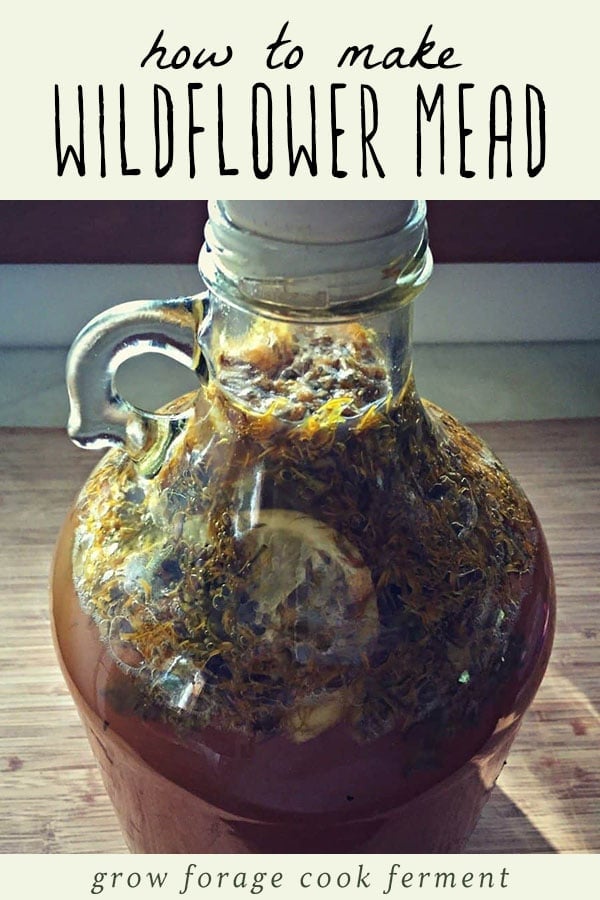
Want to save this post for later?
Simple Mead Making Ebook
Want to learn more about making mead? I have a Simple Mead Making for Beginners eBook just for you!
It has ingredient and equipment checklists and detailed instructions for brewing and bottling your mead, so be sure to check that out if you’re new to the mead making process.
Wildflower Mead in Summertime
Early summer is such a beautiful time of year. Wildflowers are blooming everywhere and it’s a great time to start putting them to good use, in fermented form of course!
I’ve used wildflowers in my homemade salve, but I want to make sure I get a gallon batch of mead going before it’s too late. I will show you how to make this delicious wildflower mead!
Wildflower Mead Recipe
Making mead is actually fairly simple, easier than beer even (brewing beer is somewhat complicated, to be honest). The basics are the same for all wines and meads, you just change the flavorings to your liking.
I’ve done a post on how to make a gallon of mead, and this follows that recipe very closely. Another favorite is dandelion mead.
Here is everything that you will need:
- 2-3 pounds raw honey, preferably wildflower honey
- Edible wildflowers of your choosing
- A small handful of golden raisins
- 1/2 lemon
- One gallon jug with lid and airlock
- Champagne yeast
- Sanitizer (I like One Step brand)
- large pot, big spoon, and funnel are also very helpful
Gathering Flowers for Mead
The first thing that you will need to get started for this batch of mead is, of course, wildflowers! I used dandelion, yarrow and lavender becasue they were growing right in my yard, but any edible flowers will do.
They don’t even technically need to be “wild” flowers, as many cultivated flowers are edible as well. Some other good choices are calendula, nasturtiums, or wild violets.
If you use dandelion (and I highly suggest that you do) you will need to separate the petals from the bitter green parts. This is not an easy task, which is why I decided to do a mixed wildflower mead.
Because it is so time consuming, you can freeze the dandelion petals in small batches as you collect them, until you have enough.
That’s exactly what I did and it worked perfectly! About ½ cup or a little more of dandelion petals is plenty.
Brew the Wildflower Mead
First, make sure to sanitize everything that will come in contact with your mead making, including the jug and lid, large pot, big spoon and funnel. Keep the sanitizer handy in case you need it later on.
Roughly chop the flowers, cutting off as much as the green part as possible. A little bit of green on these is ok because they aren’t nearly as bitter as the dandelion greens are. Some bitterness is good for brewing as well.
Put about a half gallon of water into a big pot with the flowers and bring to a boil.
Once it comes to a boil turn off the heat and let the flowers steep for at least 20 minutes or so. While the water is still warm add the honey and stir it until it dissolves.
The lavender lost its purple color after boiling, it turned green!
The smell of this wildflower tea was absolutely amazing. Use the funnel to pour the “must” into your one gallon jar.
Add the golden raisins and ½ lemon, thinly sliced.
Top off with pure (non-chlorinated) cold water, leaving a few inches of head space.
Pitch the Yeast & Ferment the Wildflower Mead
Then add the champagne yeast, but first make sure that the temperature of the “must” is 90°F or less (preferably 75°-80°F).
Use a thermometer if need be, and when it’s cool enough add ½ package of yeast (refrigerate the other half for later use).
Cap the jug and shake it for a minute or two to distribute the yeast. After shaking, you should see the little yeasty beasties floating around. Cute, aren’t they?
Then put your rubber stopper with airlock (filled halfway with water) on the top of your jug and wait for the lovely bubbles to start forming.
The next morning it should be bubbling pretty vigorously.
All the flower petals may start to bubble up towards the top of the jug, just stir them around a few times throughout the first day or two with a sanitized butter knife or chopstick if need be to get the bubbles out.
Let it ferment in a cool dark place for about 4-6 weeks, or until it completely stops bubbling.
Bottle and Age the Wildflower Mead
Once the wildflower mead is done fermenting, you can bottle it and let it age for up to a year or even longer.
I’m probably going to drink mine before that, though! The lavender gave it a wonderful scent and mixed with the other wildflowers it was intoxicating!
This mead turned out absolutely wonderful, dry with only a hint of sweetness and a lovely floral flavor and aroma. I have to admit, I was a bit worried that the yarrow was going to make it bitter, but it wasn’t overly bitter at all.
More Mead Recipes
Ready to start brewing your next batch of mead? Here are 15 mead recipes for you to try including:
Hope you like it, and happy mead making!
Wildflower Mead
Equipment
Ingredients
- handful wildflowers of your choosing
- ½ gallon boiling water
- 2-3 pounds raw honey preferably wildflower honey
- small handful golden raisins
- ½ lemon
- ½ gallon cold water
- ½ package champagne yeast
Instructions
- Sanitize all equipment that will come into contact with your mead.
- Roughly chop the flowers, removing as much green material as possible.
- Put about a half gallon of water into the big pot with the flowers and bring to a boil.
- Once it comes to a boil turn off the heat and let the flowers steep for at least 20 minutes or so.
- While the water is still warm add the honey and stir it until it dissolves.
- Use a funnel to pour the “must” into the one gallon jug.
- Add the golden raisins and ½ lemon, thinly sliced.
- Top off with pure (non-chlorinated) cold water, leaving a few inches of head space.
- Add the champagne yeast, making sure that the temperature of the “must” is 90°F or less (preferably 75°-80°F). Use a thermometer if need be, and when it’s cool enough add ½ package of yeast (refrigerate the other half for later use).
- Cap the jug and shake it for a minute or two to distribute the yeast.
- Put the rubber stopper with airlock (filled halfway with water) on the top of the jug and wait for the bubbles to start forming.
- It should be bubbling vigorously by the next morning. All the flower petals may start to bubble up towards the top of the jug, just stir them around a few times throughout the first day or two with a sanitized butter knife or chopstick if need be to get the bubbles out.
- Let it ferment in a cool dark place for about 4-6 weeks, or until it completely stops bubbling.
- Once it’s done fermenting you can bottle and age it.


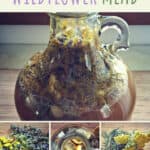
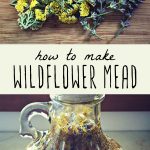
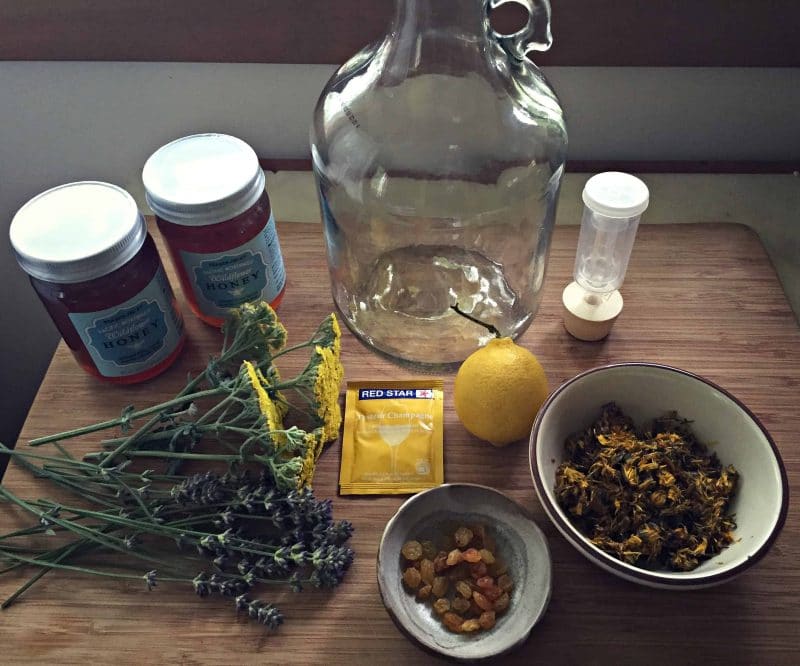
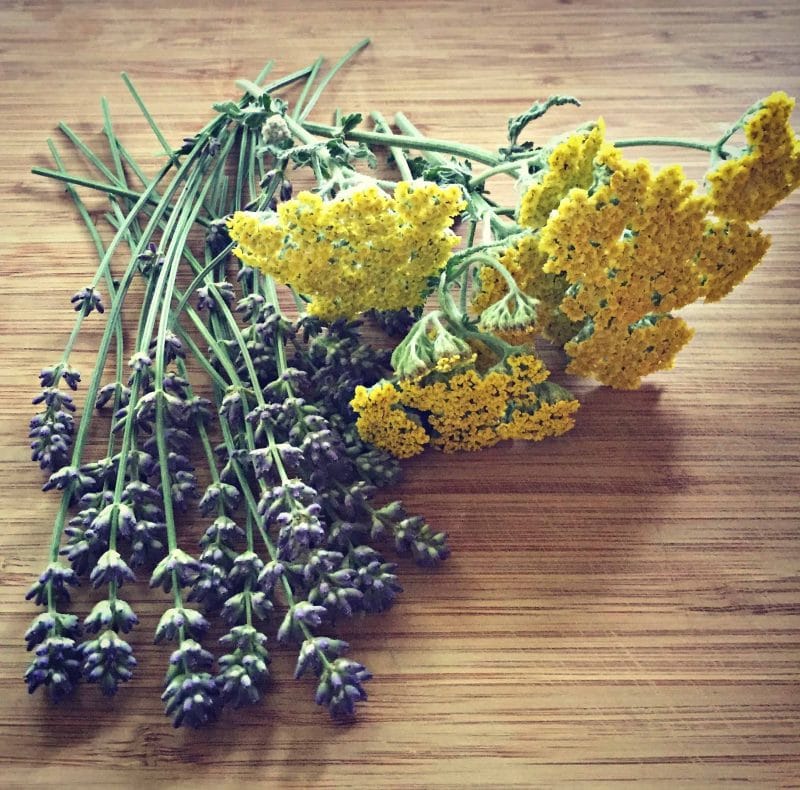
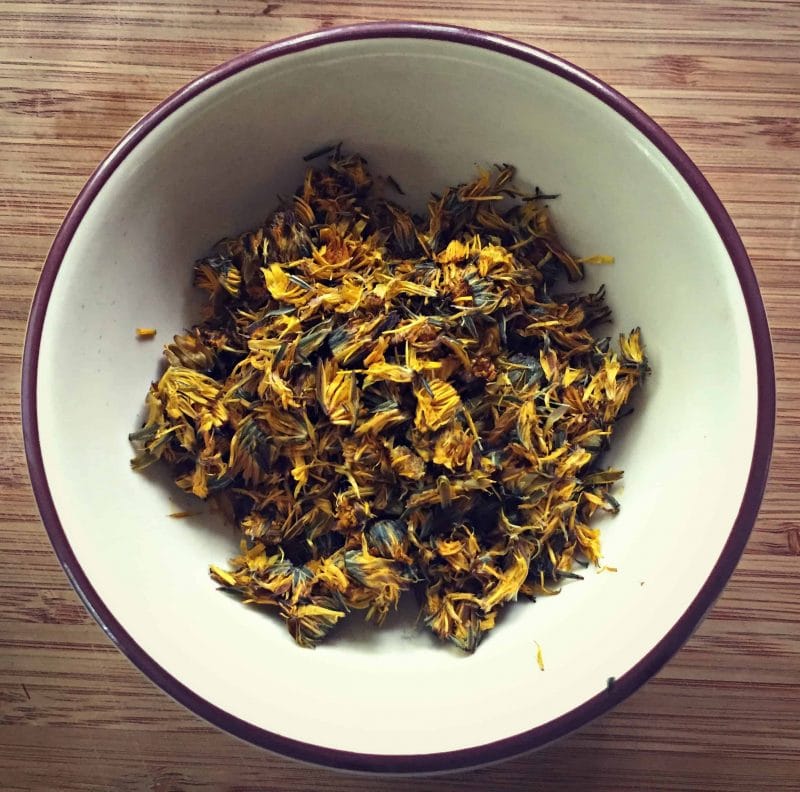
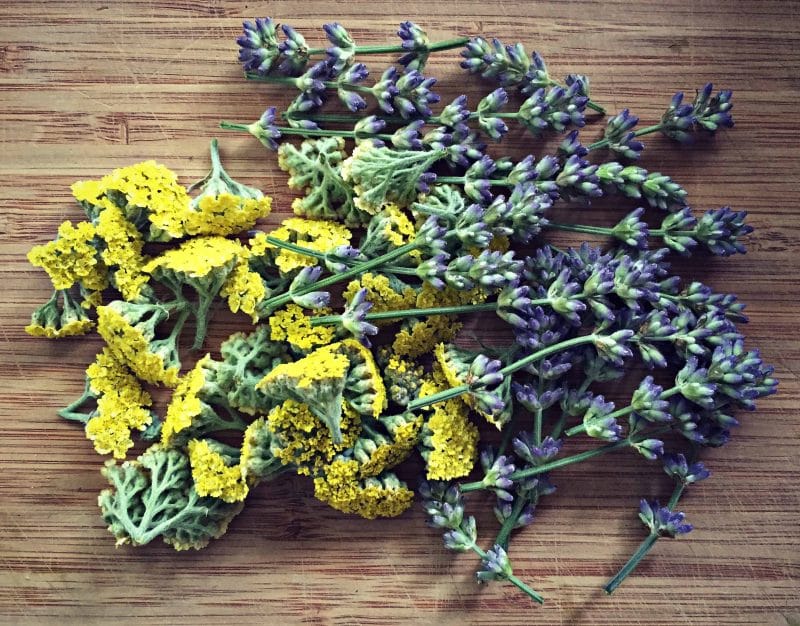
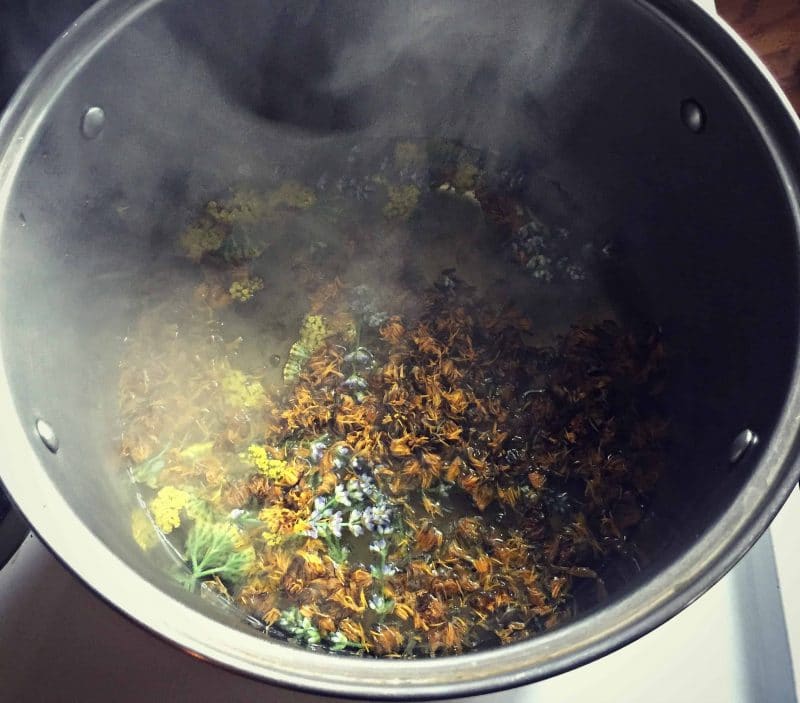
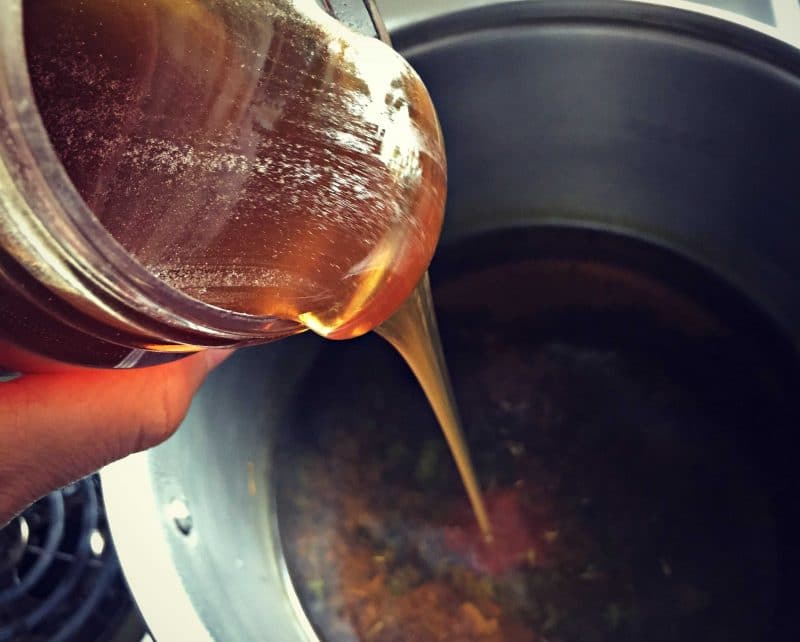
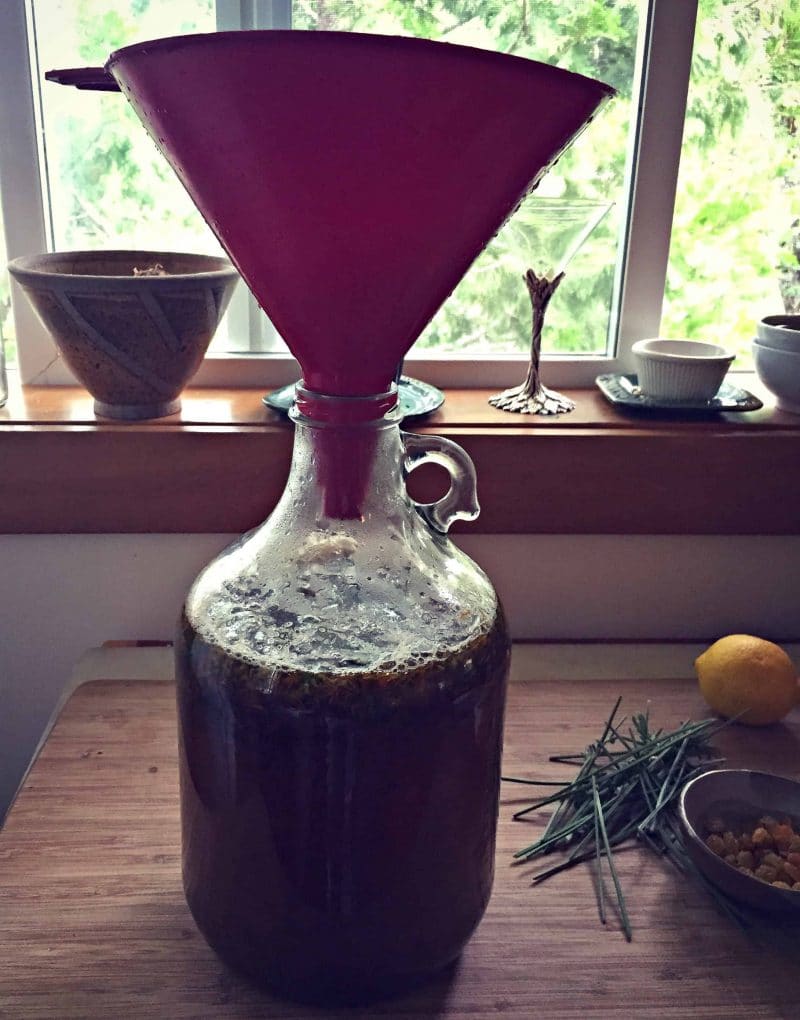
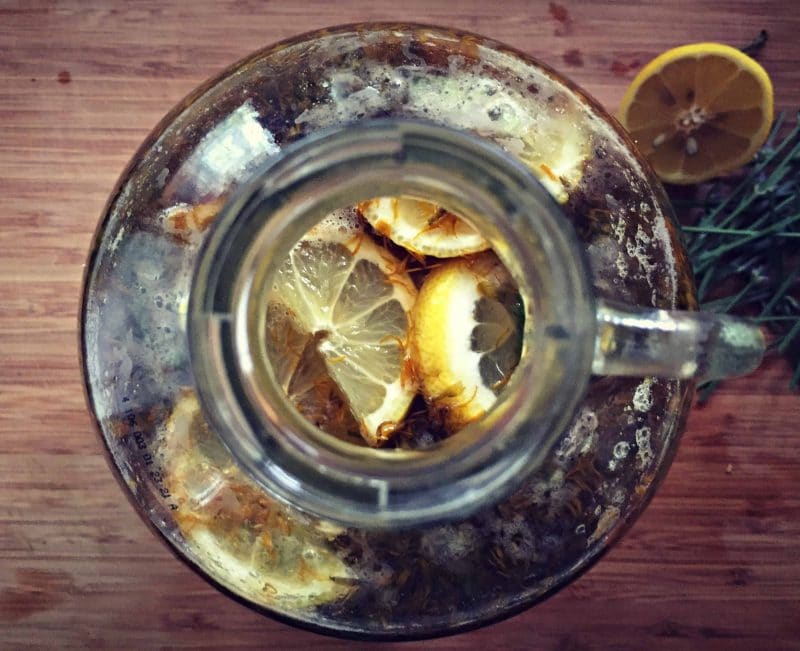
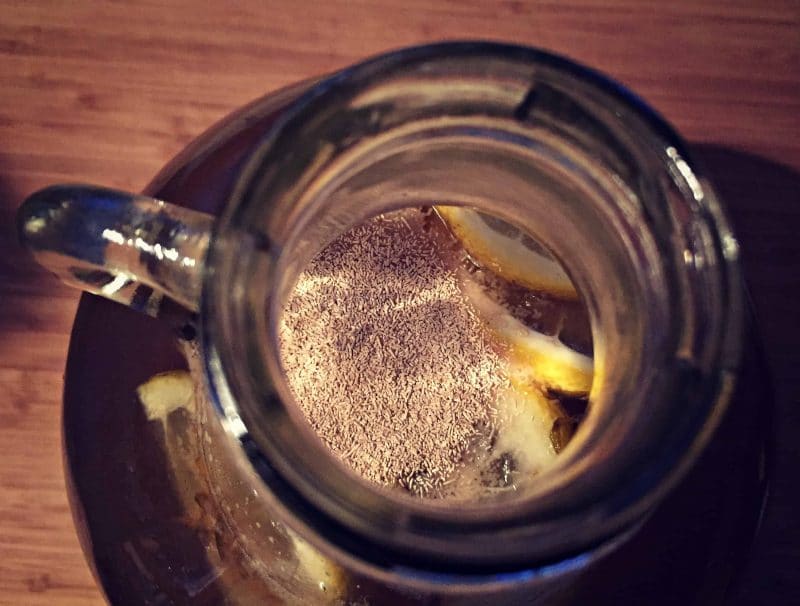
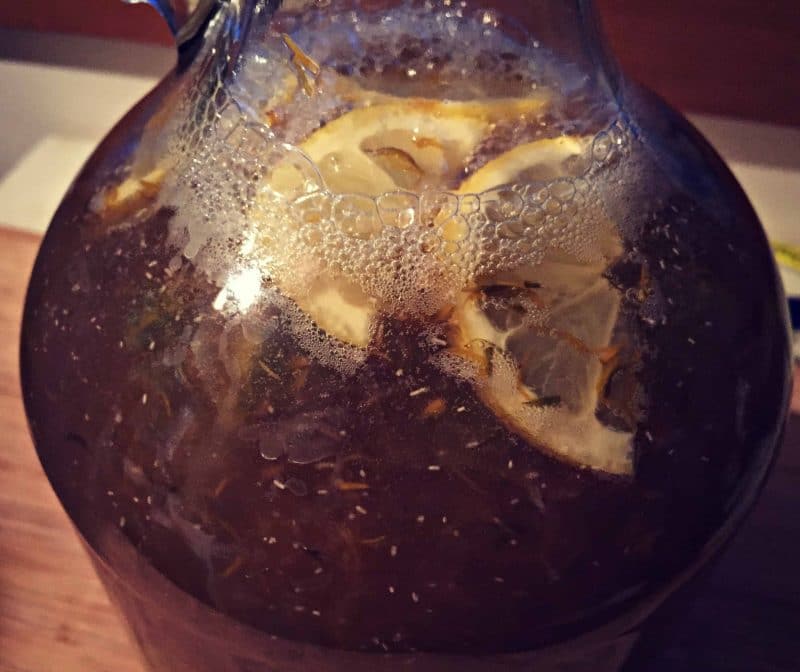
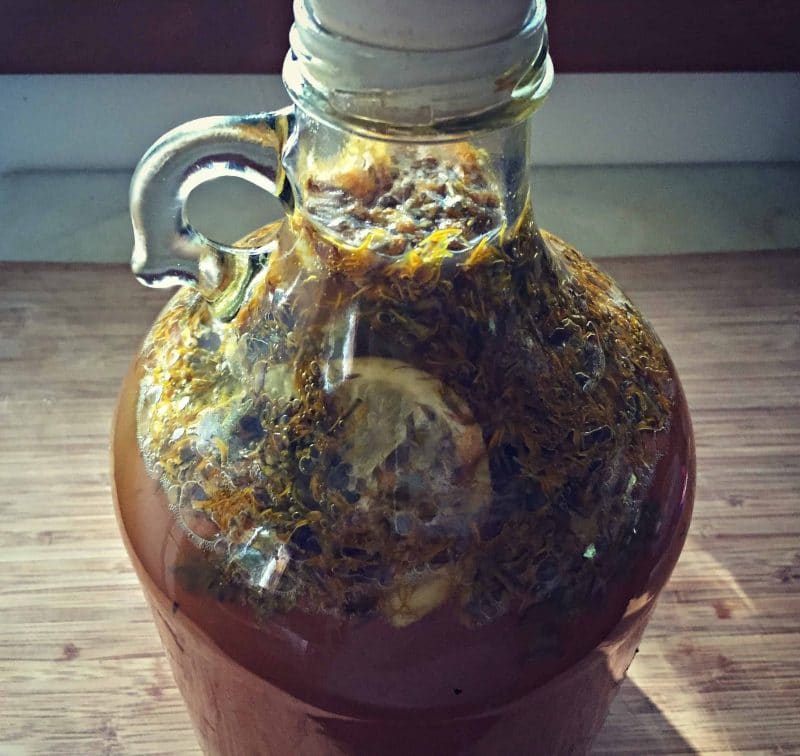
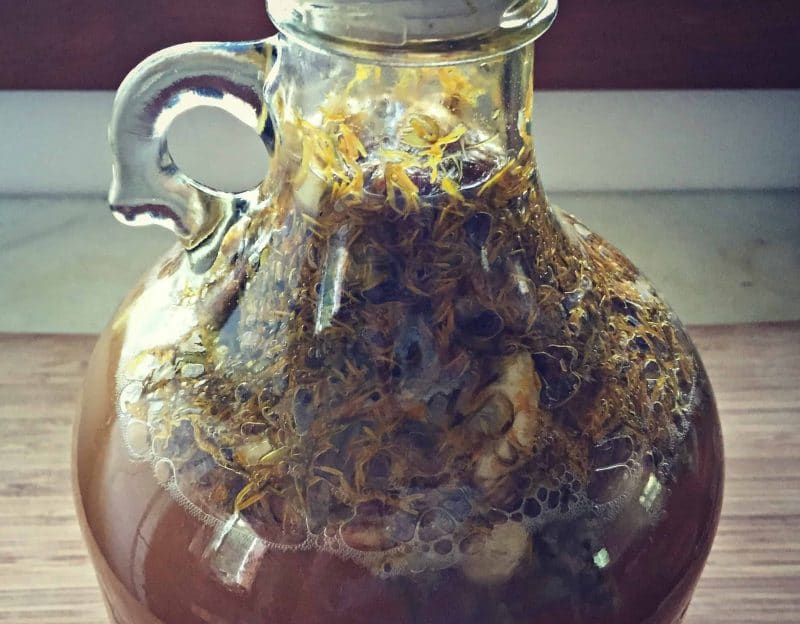
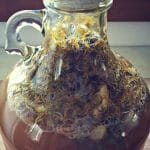

How much is ½packet of yeast exactly…… If I am buying in a large pack of it
I’m not sure. I’ve only used the small packages that contain 5 grams of yeast, so half of that?
My Concern would be with the champagne yeast you might blow the airlock off that jug. Its a very fast acting yeast. I definitely want to do this with my flowers in the Spring.
Could I use honeysuckle fowers
You definitely can!
Hello!
I’m on day 4 of my Chamomile Lavender and Orange Blossom honey Mead. Did you filter out your herbs before letting it ferment for 6 weeks or did you leave the herbs in there until bottling?
Thank you!
To make sure I got this right. You used 32+ ounces of honey for a 1 gallon batch? Seems like a lot. But I’ve never made wildflower mead. I have done mostly berry and maple
I was wondering the same thing. 2-3 pounds of honey per gallon. Makes a real sweet mead, right? Is mead a wine or syrup?
Leona
Do you have any go ideas for prickly pear mead? I just started my second batch of J.O.A.M. mead. (Joes original ancient mead). I’m also making some prickly pear jelly. Long story short. I found this page and began to wonder about prickly mead and now honey suckle jelly. Any help would be grand. Thanx in advance.
J.R.
I don’t, but that sounds great!
Thank you so much for your mead tutorials, I bought a book to learn about this and it just confused me, you way is so much casual and easier to follow and can’t wait to get started! How do I measure the alcohol content once it’s finished?
You would need take a hydrometer reading both before and after fermenting. I’ve actually never done it, so that’s about all I know about it! Most meads have about the same alcohol content as a strong wine :)
Seeing this today has got me back to thinking I want to make some honeysuckle mead. I need to get the golden raisins bought and a lemon but otherwise, the honeysuckle is blooming like crazy and maybe I should pick and freeze so I will be ready when I get back from the store this week.
We are still enjoying our gallon by gallon batches I made last summer. Cinnamon peach, blackberry and elderberry
I would love to try this. I tried my hand at Dandelion wine last year. It tasted the way I imaging dirty socks would…oh well.
That is sad, cause mine is some of the best tasting wine I ever make. I have now switched to elderflower tho. It makes a wine that tastes virtually identical to dandelion and the flowers are easier to pick
These pictures are so lovely and instructive!
I am new to mead making. This was my first attempt (i was using your recipe here). Your instructions didn’t mention that the airlock needed to have water in it and since there was no picture of it – i missed that step) my mead has been fermenting for 6 weeks now. I was just reading instructions on bottling it when i saw pictures of airlocks with water in them – did i ruin my mead?
Hi April, I’m so sorry that I didn’t mention that in this post! I know that I’ve said it in my other mead posts, but I must have forgot it in this one. I’m going to edit it right now so that other people don’t have the same problem as you. It’s hard when I’ve been doing something for so long to remember all the little details that a total newbie might not know! Anyways, the good news is that your mead is most likely ok. People have been making alcohol for centuries as open ferments without airlocks. The main thing that could happen is that it will turn to vinegar, but that’s if you leave it exposed to air for many months. Especially since I’m assuming you used a packet of commercial yeast, that yeast will be dominant over any wild yeast, at least until the end of fermentation. Are you still seeing tiny bubbles rising in the mead? If so, I would put some water in the airlock and let it keep going. If not, give it a little taste. It will be a strong alcohol flavor, but it shouldn’t taste like vinegar. Go ahead and bottle it, the taste will mellow a bit with time. And I would suggest drinking this batch “young”, which means not aging it for more than a month or two at most, just in case the vinegar beasties got in there. Regardless, it’s not going to kill you or make you sick, it just may taste a little off. But, also know that mead has a different flavor than most are used to. Please let me know how it turns out!
Just a question. I came upon your recipe while researching how to add flowers to mead. My question is: don’t you have to sanitize your flowers first? What if there are wild yeasts/bugs on those flowers? I’ve been trying to find a way to best sanitize my lavender, dandelions, heather, and yarrow that I plan on using for my next batch of mead, but aside from making a tea, I couldn’t really find any other way to accomplish this. Thanks!
Good question, I wouldn’t worry too much about it, though. In my recipe you boil the water and then let the wildflowers steep which will take care of the sanitizing for you! And the addition of the champagne yeast will out compete any other wild yeast that might be there.
Your tutorial is wonderful and thank you for sharing ! I have a question when you age it do you do it in the refrigerator or on the counter? I know it’s probably a dumb question but I tried wine making with beets a few years back and I refrigerated it and just used the last bottle a few days ago. I followed a simple recipe for it but have found everyone says age it but doesn’t specify the ideal place. I have chamomile ready for your recipe and can’t wait to try it out. I bet cinnamon basil would be nice to for a different batch?
I’m sorry I didn’t say that was a question I truly was trying to find out if you age it in the refrigerator? I haven’t really had an opportunity to find out
Hi Deanna, you don’t need to age it in the refrigerator. A cool and dark out of the way place is best, a basement or root cellar would be ideal, but a closet would also be fine. Just make sure to keep it away from sunlight!
Hello! Thank you SOOOOO much for this article, and I *love* your blog!!! I can’t wait to try this recipe out and make it for the Summer Solstice to drink at Christmas time (you know….to remember the sun? lolol!). I just wanted to know how your mead came out and if it tasted good! And would you do anything different/add different flowers to it? Or more or less of another you used? Thank you again for this article!
You’re welcome, I’m glad that you like it! The mead is still fermenting, so I haven’t tried it yet, but I will definitely let everyone know in one of my updates posts how it turns out!
When I go to bottle this, how would you recommend I get the “must” out before siphoning?
You may have misunderstood, which is totally understandable! The must is the liquid that is fermenting. When you siphon it you are taking the liquid out and the herbs should stay in the bottle, ideally. With all of the little dandelion flowers, however, you may need to put it through a strainer. Great question!
This looks great. How many ounces of wildflowers for this recipe? Can dried flowers be used or just fresh? Also, why did you choose to add golden raisins and lemon slices? Just curious if that is a personal preference or does it do something during the fermentation process. Thanks!!!
Thanks, glad you like it! I didn’t measure the amount of wildflowers that I used, I don’t think it really matters to be honest. A couple of handfuls for a gallon batch should be plenty. Raisins are often added to meads to add tannins and as a natural nutrient for the yeast, so I would definitely use them (although they don’t have to be golden, they just match the color of this particular mead). Citrus is also often added to mead to give it a little more acid and I thought that lemon would go nicely with this mix, but it’s not absolutely necessary.
Thank you! What about dried vs. fresh flowers?
You could use either! Just be aware that dried herbs & flowers are more concentrated so you wouldn’t need to use as much.
This looks really great and very easy. I’m going to have to try this some day.
Thanks for sharing.
That’s amazing !
Looks really good, and super easy. Would chamomile work well?
I haven’t managed to source any gallon jars with rubber stoppers here. Probably because homemade mead isn’t common – it’s a beer country, and it’s too cheap and easy just to buy pre-made. Must go on a supply hunting run.
I think that chamomile would be fabulous! That may be something I try out later this summer when our chamomile plant starts flowering. I just repurpose glass gallon jugs of apple cider, then buy the right rubber stoppers that fit. You can even make hard cider first, the just reuse the jugs!
I got my gallon jug with stopper and airlock from the local brew store for about $6 bucks!!!
Where I live, there is actually a couple that started a business with their mead. Their mead is absolutely fabulous! And Chamomile is one of their flavors, delish. With it being winter now, they do a spiced apple that is wonderful warmed up slightly and adding a shot of caramel coffee syrup. I’m glad I found your website.